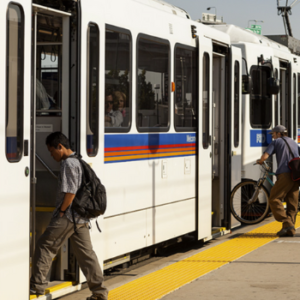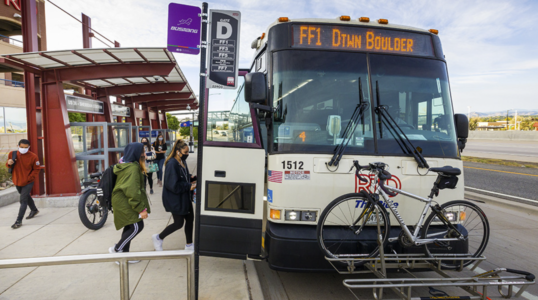By Heidi Leathwood
In August 2022, much of Colorado will have the opportunity to explore getting around via public transportation for free.

Photo: RTD
This month much of Colorado will have the opportunity to explore getting around via public transportation for free. Check out this great free transit denver website for lots of great resources: tips, tricks, and ways to share your story. Here is a map of all the systems statewide that are offering free transit during August (and some of them offer free transit all year round). Note that Denver RTD also provides service to many surrounding communities (map here). Along with many other cities in the state, service on the RTD will be free, as well as all airport trains, access-a-ride, and more. Learn more about the program on RTDs informational webpage or Colorado Association of Transit Associations website. Sign up for the trip tracker: this will track how much gas you saved and enter you in a raffle for prizes (one raffle ticket for every day you ride.)
Public transportation is key to fighting ozone pollution in Colorado.
This program came about in response to the high ozone levels in our state, and was proposed by Governor Polis in November 2021, as part of the state budget. Ultimately Senate Bill 22-180 was passed by both the Colorado Senate and House and signed into law by Governor Polis in May of this year. The bill created a grant program to be administered by the Energy Office. Grants are given to the RTD and other transit services to enable them to offer zero-fare transit. Each participating transit association is required to submit a report about the services offered, and how their ridership increased as a result. The bill also requires the the department of transportation to create a 3-year pilot project to extend state-run transit services throughout the state with the goals of reducing ground level ozone, increasing ridership, and reducing vehicle miles traveled in the state.
Here’s where the organized climate movement comes in. It is critical for us to support our transit and show interest during this free month. This is important even if the system is not currently perfect. If you are able to ride transit, by showing up you can demonstrate that we care and support the idea of using transit. By following up afterward by letting our officials know we want an expanded, more convenient system (and letting them know any other concerns and needs we have), we can be the catalyst to push Colorado toward developing a world class transportation system accessible to all and that we can all be happy to ride. Let’s help build momentum.
Reducing emissions from transportation is vital to our success in transitioning to the clean, green world we envision.
According to the 2021 Colorado Greenhouse Gas Inventory Report, transportation is one of the highest emitting sectors. Transportation emissions are also a leading cause of our deadly ozone pollution. Though switching to EVs is important, we cannot put all our eggs in that basket. First of all, not everyone can afford EVs: basing our plans exclusively on EVs is not equitable. Secondly, EV adoption alone will not solve congestion. Thirdly, EV adoption is currently gradual. The pace for that will need to increase, and we will need additional reduction measures. Currently there are 49,000 EVs on the road, with a goal of 940,000 by 2030. To accelerate emissions reductions, getting off the road and onto transit, bikes and sidewalks is a key part of a successful strategy. This will require a system change that we can instigate. Showing up to zero-fare August is the first step toward the goal.

Photo: RTD Toolkit
Why you should participate in free public transportation this month:
If enough people do this, we will see substantial air quality improvement and greenhouse gas emissions reductions, and there are many other great benefits for individuals:
- Exercise (walking or biking to your stop) is built into your day: get in those steps!
- You won’t be stuck in traffic
- Save money on parking and gas
- Leisure: Relax or read a book while you are getting where you are going
- You don’t have to look for parking
- Feeling connected with your community
- Save time: catch up on work or emails while riding
- Reduce or eliminate traffic stress
- It’s fun to travel this way with friends
Not that familiar with riding transit?
Check out these Tips for a smooth ride from Nathaniel Minor of CPR for many practical hints, from how to let the bus driver know you want to exit to the easiest ways to plan your trip, and how to stay safe.
More public transportation tips from 350 Colorado:
Buses and light rail are comfy and air conditioned.
The light rail has access ramps for wheel chairs, and buses are equipped with lifts.
It will take a few days to get used to a new mode of travel. Allow yourself a little extra time at first, but once you get the hang of it it’s easy!
There are bike racks on the front of buses, and bikes can be taken on the lightrail (but you have to lift it up and down the steps). Currently e-bikes are not allowed but they are working on that. You may be able to take your e-bike on if you can remove the battery.
Sometimes a bus or train will come 5 minutes early and will not wait. Occasionally a bus or light rail doesn’t come. If you are going to a super important event like an interview, aim for getting there 30 minutes early just in case, and then you can use the extra time at your destination to relax before the event.
If a train door closes and you want it to reopen, press the green button.
The light rail announces stops. In Denver RTD, (not sure about other systems) most (maybe all) the buses announce stops on an automated system. If your bus doesn’t, tell the driver what stop you will want to exit and they will help you. The apple “maps” app on your phone tracks along and lets you know as you pass each stop. [hint: charge your phone before going and bring a portable charger for your phone].
If you have a long trip and want to read a book without worrying about missing a stop, set an alarm on your phone for a few minutes before you are expected to reach your stop.
Sunglasses are nice to hide behind if you are so inclined.
Fun facts:
A ride on transit emits 84% less carbon than driving an internal combustion engine (RTD)
84% of transportation emissions are from the daily commute (RTD)
Taking the bus and train saves on car expenses including maintenance, parking, and tolls, which add up quickly. A household can save nearly $10,000 by taking public transportation and living with one less car (RTD)
The Maryland Transportation Institute finds that 52% of all trips in the US, using all modes of transportation, were for distances of less than three miles. Some 28% of trips were for less than one mile.
Car trips of under a mile add up to about 10 billion miles per year in the U.S., according to the 2009 U.S. National Household Transportation Survey (NHTS)
